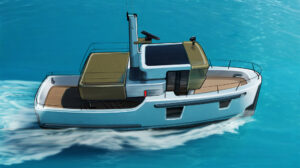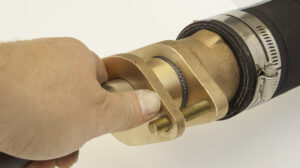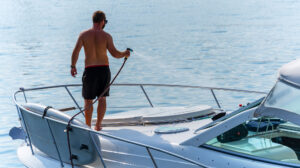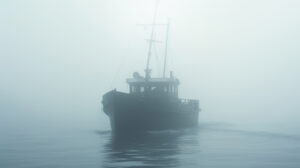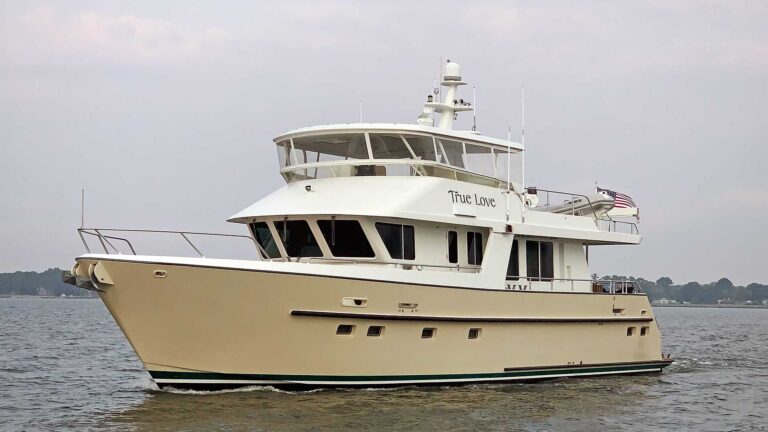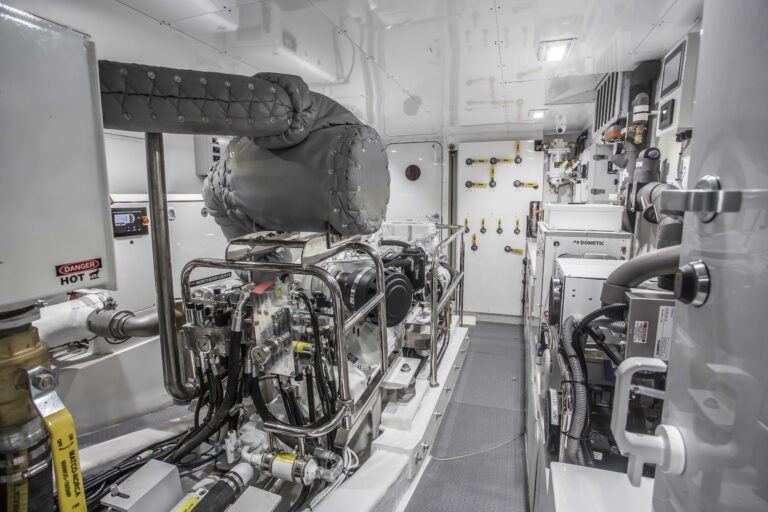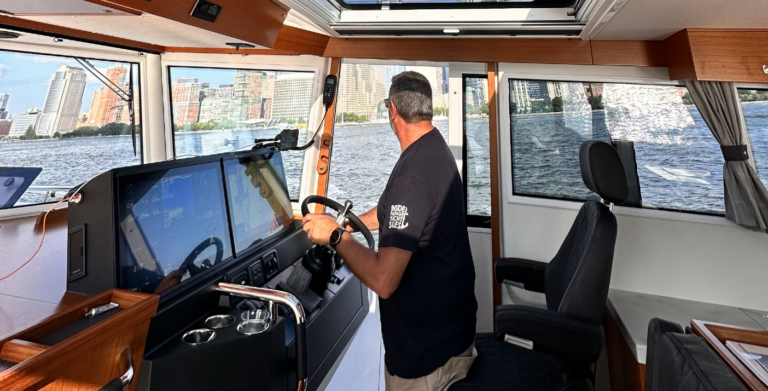Over the past 300 years, boat steering has evolved from paddles to tillers, then tillers with rope to whip staffs, then steering wheels to fly-by-wire joysticks. On modern cruising powerboats, the steering wheel controls the rudder by one of three methods: cable, manual hydraulic, or power hydraulic. Each has unique inspection and maintenance requirements. Regardless of the system and the upkeep, it pays to understand the likely failure points and to have a rehearsed backup plan.
Basics
Some boats have a stainless rudder welded directly to a rudder post; others have a framework welded to the rudder post that is encapsulated in foam and fiberglass. In both cases the rudder post penetrates the hull, protruding into the lazarette or cockpit. In a previous column, we looked into various types of propeller shaft seals, and here the rudder post presents some of the same challenges and solutions.
Inside the boat, a steering quadrant or tiller arm attached to the rudder post (see photo above) provides the leverage needed to move the rudder against the force of the water. In addition to a solid means of clamping to the rudder post, a key and keyway prevent slippage. With the rudder, rudder post, and tiller arm solidly in place, we need a method to transfer power from the helm. Before we look into inspection and maintenance requirements, you will need to identify the type of steering on your boat.

Cable steering
Most older boats rely upon stainless cables running from the helm station to the rudder post. These cables pass through and around a series of sheaves and then attach to a quadrant affixed to the rudder post. Cable steering offers the following advantages: It’s simple, reliable, and serviceable. On the other side of the ledger, cable steering requires the helmsperson to apply the power, and there can be a fair amount of slack in long cables.
Hydraulic Steering
Hydraulic steering uses a hydraulic pump to turn the rudder post. In these installations, a tiller arm attaches to the rudder post and a hydraulic ram attaches to the tiller arm. In general, hydraulic systems offer the following advantages over cable: Less effort is required to turn the rudder, long runs of moving cables are not needed, and steering is more responsive.

Hydraulic systems come in several configurations. But all hydraulic systems need a way to force hydraulic fluid through the lines to the ram. Some systems rely on a manual pump combined with the steering wheel—when you turn the wheel you power a small pump, which forces fluid through the system. We refer to this setup as a two-line manual hydraulic system. Manual hydraulic systems are the simplest and work well on smaller or slower boats equipped with single steering stations. The fill tube for a two-line manual hydraulic system will be at the steering wheel, usually on the other side of the bulkhead or helm console.
Multiple steering stations require a different strategy, though still being manual hydraulic. Either the upper helm will be the reservoir or a single remotely mounted reservoir contains the pressurized hydraulic fluid. These units incorporate a third hydraulic line. A fitting and gauge on the remote reservoir provides a way to pressurize the reservoir so that air does not get into the system.
The third variety of hydraulic steering uses a powered hydraulic pump. In two-line and three-line manual hydraulic steering systems, the helmsperson applies the energy by turning the wheel. With power hydraulic systems, either there is a power-assist module installed inline with the hydraulic lines or turning the wheel sends an electrical signal to a pump, which then applies the force. The pump or assist module will either be engine-mounted or remotely mounted. An engine-mounted pump most often taps into the transmission’s hydraulic pressure (called a “power takeoff” or “PTO”). A remotely mounted pump, usually near the rudder, will use DC power.
Dockside Inspection and Maintenance
If you have cable steering, here are a couple of basic annual maintenance guidelines.
• Every inch of the cable, especially where it passes over sheaves, must be checked for frayed wire, often referred to as “fish hooks.” While wearing a glove, run your hand around the entire length of cable. If you find frayed ends poking out of the cable, the cables must be replaced. New steering cable should be stainless steel wire rope, 7×19 (7 bundles of 19 wires), providing high strength and flexibility.
Attachment of the wire ends must be done properly. For a given wire size the manufacturer will specify how much wire must overlap and how many clamps are required. Cable clamps consist of a U-shape rod and a saddle that slides onto the U-bolt. The wire runs around a thimble to protect it from wear and the end of the wire is referred to as the dead end. The cable clamp secures the dead end of the wire against the other part of the same wire. It matters where you place the saddle—it must never rest against the dead end of the wire. We have a saying to remind us of the proper way: “Never put a saddle on a dead horse.”
• In addition to checking the cable, visually inspect the sheaves. Over time, misalignment can cause the side of the sheave to wear very thin, eventually allowing the cable to slip out. If the sheaves have lubrication points, these should be serviced annually.
Hydraulic systems require vigilance, too. The fluid level and air pressure in the reservoir should be checked from time to time——twice per season as a rough guide. If you are losing fluid or air pressure then you have a leak somewhere. Keep an eye on fittings and connections and if hydraulic hoses were used, check the jacket for chafe and deterioration. Seals can fail on the hydraulic ram. Check the ram arm for pitting or corrosion—rough surfaces will ruin the seals. Also look for hydraulic fluid accumulation under the ram.

Hydraulic fluid will not compress—any movement of the pump translates directly into movement of the ram and the rudder. While stainless cables can stretch and create some looseness, hydraulic fluids allow no such leeway. If you feel any give, delay, or sponginess in your hydraulic steering, then you have air in the system. This slop often appears first in the flybridge station, eventually cropping up in the lower station. Bleeding the air out takes some patience, and you will want to consult the manufacturer’s manual.
Underway Inspection
Regardless of which steering system you have, the following inspections apply.
• The underway checks require two people, one at the helm and one at the rudder post(s). At cruising speed the operator should turn the helm hard over in one direction for a full turn and then reverse direction. During this procedure, closely inspect all of the attachments around the rudder posts: the tiller arm to rudder post, hydraulic ram to tiller arm, rudder post bearing, and all structural attachments. No shifting or slack should be taking place. Any looseness will lead to a failure. Repeat the process twice for each rudder.
• While you’re there, check the rudder shaft seal for leaks and movement. Depending on the type of seal, a small amount of water might come in, but it should not be streaming in.
Backup Plan
If you’ve never rehearsed what to do if your steering fails, I highly recommend it. Some boats have an emergency tiller that fits on top of the rudder post. Assuming you know where to find and assemble it, fitting the tiller onto the post can be difficult. A bit of corrosion or tight machining can prevent you from making the connection. Can you see where you’re going from the emergency tiller? Can you control it in rough conditions? Do you know how to bypass the hydraulic system so that you can move the rudder? Unless you are offshore, calling a tow company might be your best option.
If properly planned and set up, you might be able to steer with your autopilot. If a common point between the steering system and the autopilot has failed, though, you are out of luck. If, for example, the ram has failed or the tiller arm has broken, then neither system will work. But if the steering pump has failed and the autopilot has its own pump, then you have a backup system. If you are not sure, ask a marine technician to look at your setup and explain your options.
Staying On Course
The short list of critical systems on your boat would start with the engine and drive train, followed by the steering system. Fortunately, the maintenance needs of steering systems are minimal and inspections are very straightforward. If you follow the checks and procedures described above you will greatly reduce the risk of failure. And if you understand and rehearse a backup plan, you will have an extra measure of safety and peace of mind.


